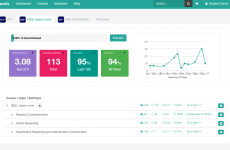As we move into 2015, the New Year will undoubtedly bring new challenges and opportunities to education and learning. Many ideas and trends started in education in 2014 will gain more momentum and some may even reach their apex in the coming year. DistrictAdministration.com and the Washington Post collected some of the most interesting and likely predictions for what changes to expect in education in 2015.
Common Core State Standards – The political volleying of rhetoric and implementation (or lack thereof) around Common Core will likely continue in 2015. For the districts that have successfully implemented CCSS, there is concern about how the curriculum will adapt for overall student learning differences and cognitive development.
Some districts will continue to modify the curriculum to adapt for their needs. The aggregate changes to CCSS based on individual districts observations and assessment will ultimately determine if the program is successful and worthwhile enough to hurdle over the politics that have dogged it throughout 2014.
Testing and Assessment – Steven Webb, Superintendent of Vancouver Public Schools, Washington State, predicts a shift in 2015 nationally away from “single-event, high stakes assessments” towards a greater willingness to utilize “multiple measures that demonstrate a broader and more balanced view of student, school and district achievement.”
Kenneth Tran, Executive Director of Personalized Learning for Curriculum Associates, sees schools taking on a more personalized learning model that will be more adaptive and push learning to cater to the individual student. Jim Larimore, Chief Officer for the Advancement of Underserved Learners at the ACT, says that his organization will work to “disaggregate data by more specific sub-groups,” to find out how to adapt standardized assessments to best assess and meet the needs of each student.
Blended & Online Learning – Computers and technology are undeniably important tools to education and learning for students in the digital era. Most US schools at this point have been able to implement some sort of expansion of technology to enable each student to have access to a computer, like 1:1 laptop programs.
Hopes are high for blended and online learning. Susan Patrick, President and CEO of the International Association for K-12 Online Learning (iNACOL) sees digital learning as a solution for many traditional challenges like “increasing access to courses, overcoming teacher shortages, connecting out-of-school learning and addressing the gaps in student learning through targeted intervention.”
Teacher, writer and education blogger Larry Ferlazzo predicts that although E-Rate federal money will be utilized to connect more schools to high-speed internet, results will not likely show an increase in learning if students don’t have laptops to connect to the internet. Ferlazzo also sees the need for “high-quality professional development for teachers” so they can use their new tech for more than “nifty virtual worksheets.”
STEAM – One of the most exciting trends predicted for 2015 will be the rise of STEAM. As the demand continues to increase for students knowledgeable in and application of science, technology, engineering and math principles, STEM has been championed as the subject of the new millennium. However, fans of the softer sciences have been left out in the cold a bit and see STEM as exclusive to those with a predilection for numbers and calculations, without any regard for the arts. STEAM seeks to marry both the right and left brains for the overall betterment of cultivating student’s minds.
Championed by the Rhode Island School of Design, STEAM seeks to place art and design into subjects like technology and computer science to ensure that beautiful design and form are not mutually exclusive to the function that STEM is serving in preparing students for the changing economical demands of our technology reliant society. By encouraging educators to make their lessons connect across subjects, students will be better equipped to see the connections between the arts and science, making them better creative thinkers and problem solvers. Meghan Reilly Michaud, a Fine Arts teacher in Massachusetts and trustee of the RISD hopes that STEAM will help our society view arts a “necessary compliment and support to STEM.”
College and Career Readiness – Kaya Henderson, chancellor of the DC Public Schools System acknowledges that 2015 should shift the focus of high schools towards better preparing students for the “high expectations of college and the future workforce.” She sees the need for a “competency-based approach to learning,” where students master each core subject by graduation and have been exposed to real-world problems and scenarios throughout their high school years.
Kari Arfstrom, Executive Director of HVACR Workforce Development Foundation notes that in the next decade “30 million employees are set to retire [and] 100,000 skilled jobs will be unfilled” if there is not a greater effort to fully integrate career and technical education into the curriculum.
Scott Noon, Executive Director for Business Development at the Institute for Student Achievement, sees Career and Technical Education curriculum “flourishing” in 2015 as CTE “provides opportunities to contextualize learning and provide real-world application for coursework.” He also cautions against letting current standards of CTE curriculum fade in importance and become similar to vocational-technology programs of the 1970s & 1980s.
Feel free to include your own 2015 education predictions in the comment section! Happy New Year!



























One Comment